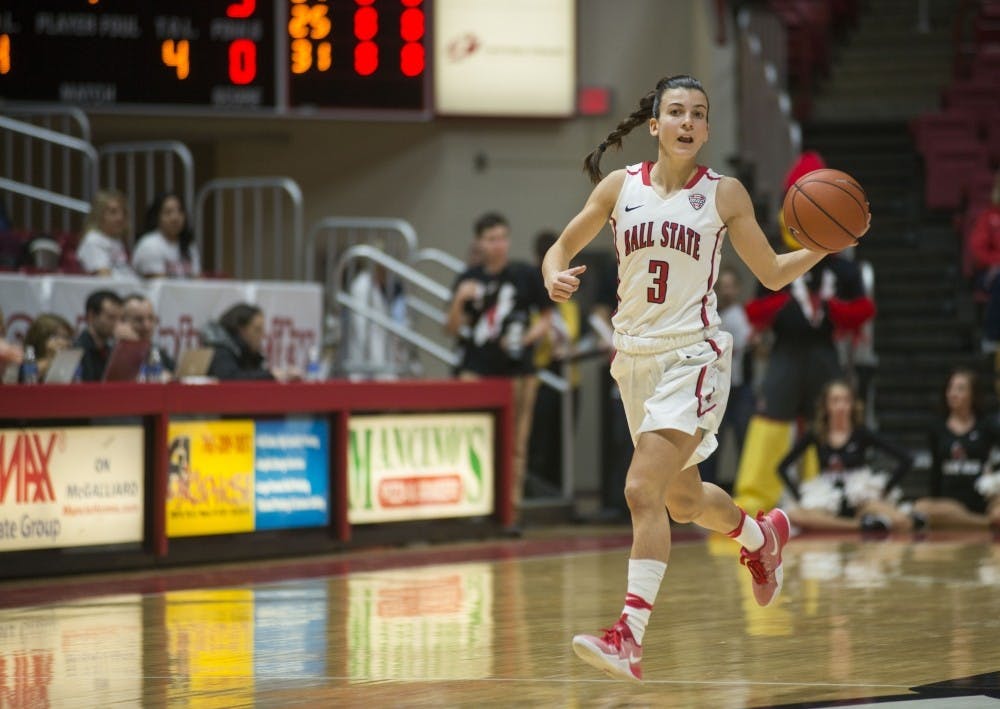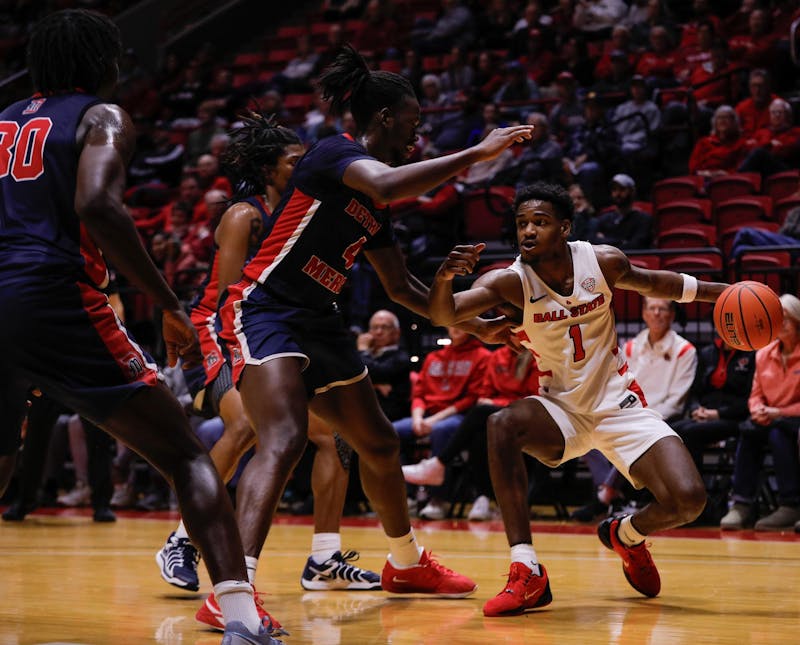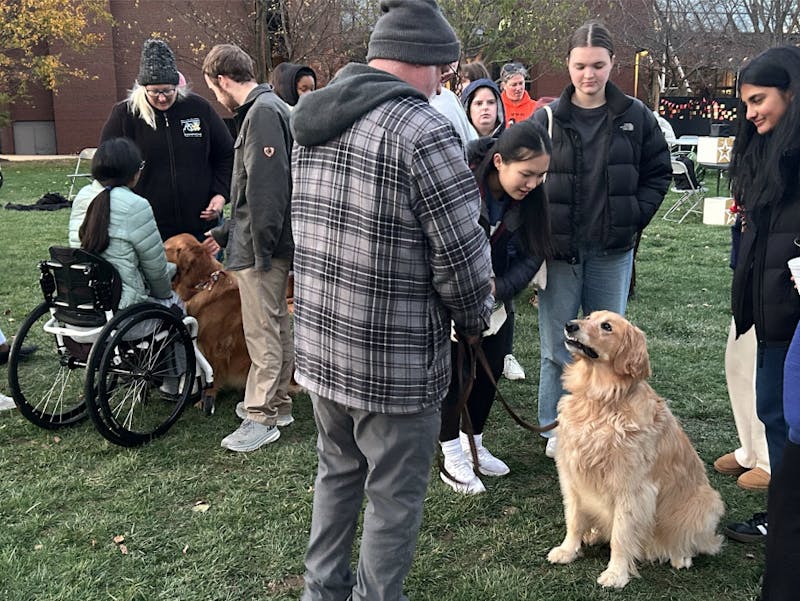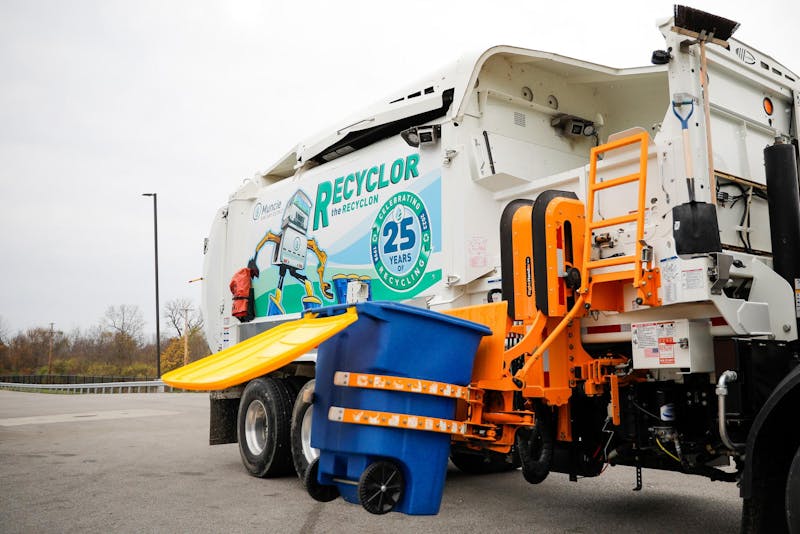Every few days, the general ruckus of the Rec is interrupted by routine.
A couple guys are usually running the floor on the court in a semi-organized attempt at reliving the high school glory days, and the one guy who can touch rim tries to dunk, convinced his vertical has improved by two inches since the last time he tried.
But it isn’t until an errant 3-pointer rolls onto the next court that anyone notices the 5-foot-8-inch girl with a long, dark brown ponytail and Ball State women’s basketball gear. Carmen Grande is often the most accomplished basketball player on the floor, but it doesn’t matter. They just want their ball back.
They don’t realize the sophomore point guard is third in the nation with 7.8 assists per game.
Grande’s routine varies, and this year her time in the Jo Ann Gora Student Recreation and Wellness Center has been a little sporadic because of her class schedule. Sometimes she works on three-pointers, other times it’s free throws or layups.
“I want to be — how you say it — an all-over player,” Grande said with her Spanish accent. It’s subtle enough that she’s easily understood, but thick enough that a well-tuned ear can pick out her hometown of Madrid. “I want to be able to shoot the ball, pull-up jumpers, finish around the rim, create for other people. … But like right now, [my strength is] distributing the ball.”
In the preseason, head coach Brady Sallee said Grande was going to be one of the Cardinals’ keys this season. Her freshman year stat line is reminiscent of a prototypical pass-first point guard. She finished last season fourth nationally among freshmen, with 5.0 assists per game and was fifth in the MAC with 1.7 steals per game. Her assist numbers are up this season and she has 40 steals through 21 games (1.9 per game).
“Carmen is a huge part of what we’re trying to do this year,” Sallee said. “She had a great freshman year at the point, and that’s not easy to do. … And then you throw in [that] she speaks something other than English, that’s really not easy. She had a great freshman year and now she’s got to take control of this team in between the lines. Our tempo’s got to be her tempo. She’s got to be the head of the snake defensively.”
Her shooting, however, hasn’t been as great. She finished her freshman season with a 34.5 percent shooting percentage and is shooting 36.6 percent this season.
But that’s part of why she spends so much time at the Rec.
“In life in general, when you have that mindset, when people know how hard you work at it, they’re a lot more tolerant ... if it doesn’t go perfect,” Sallee said. “Because they know what you put into it. She’s not only one of the hardest workers we have, but in my career, she’s one of the hardest workers I’ve seen.”
COMING TO AMERICA
Grande isn’t the only Spaniard on the roster. Grande and sophomore forward Lucia Fernandez, who pronounces the C in her name with the Castillian “th” sound, spend a lot of time together off the court.
“Having Lucia has been awesome … whenever you forget where you come from, that’s a reminder,” Grande said. “It’s just fun because, like, it’s sometimes hard to express yourself in English and it can be frustrating. Or things that, in Spanish, you know how to say and it will be fun for people — here it will be like, “what is she saying?”
Grande and Fernandez, along with Ball State soccer players Monica Padilla and Paula Guerrero, from Valladoid and Valencia, respectively, have formed their own little Spanish community on Ball State’s campus. They can talk about their favorite foods — in Grande’s case, the thin-cut steaks her dad cooks — or Spanish-style chorizo, a salami-like deli meat. Here in the U.S., stores generally sell the Mexican-style chorizo, which is much greasier.
“I miss the food a lot,” Grande said. “Like the Skittles for the food and stuff, sometimes I’m like, ‘what am I doing with my body?’ I don’t know anymore.”
Hanging out with other Spaniards is helpful, Grande said, because a lot of people hear them speak Spanish and assume they’re from Mexico — if they can recognize the language at all.
“Like some people don’t even know what language we’re speaking because we don’t have the Mexican or South American accent,” Grande said. “But we just joke around, like ‘We’re from Spain and it’s not in Mexico.’”
The language barrier makes it a little ironic that she chose to be coached by Sallee, whose Kentucky upbringing influenced an expression-heavy speaking style that some Americans struggle to understand. Colloquial words like “squirrelly” and “daggone” make regular appearances in his press conferences, and Grande said his accent can be difficult to understand at times.
“Some things are weird,” Grande said. “Like last year, the first time he said ‘giddyup,’ I was like ‘What does he want?’ And I had the ball and I had to start the play. … Hopefully by the end of this year I’ll be able to understand everything, but I still struggle sometimes.”
It’s not as bad as it could be, though. Most American movies are translated into Spanish and Grande said “we get all of the music.” In school, she said they were taught British English, but she also attended an after-school academy where an American teacher led activities and exposed them to some of the nuances of American English — just not all the words in Sallee’s vocabulary.
Playing for Sallee also exposed Grande to an almost cartoonish intensity to the sidelines. Ball State’s pregame hype video features Grande passing the ball in her clips — and ends with Sallee yelling at a referee.
“I’ve learned throughout the years that no matter how people deliver the message, if they’re saying something to you, it’s because they care about you,” Grande said. “Like you’ve gotta take what the message is saying, so like whenever he’s pissed or when he’s — I don’t know how to say it another way –— rude or something, you just have to be like, OK, he wants it this way. Let’s just do this.”
Sallee can also dial it down though, often cracking jokes at press conferences. Grande sometimes goes to him with off-the-court issues, too.
“She was in [my office] asking me about leadership books, and one book was for class and the others were just for her spare time,” Sallee said. “So she’s out searching for that kind of stuff, that’s just a kid that’s wired special. Not many kids want to just read a book in the middle of the semester, especially when you’re a physics major, just in your spare time. Like, what?”
Their shared love of basketball made the transition easier for Grande, but the sport isn’t as popular in Spain.
SPANISH ROOTS
In Madrid, Grande said, the basketball courts were always booked so she couldn’t work out on her own like she can in the Rec.
“There, it works like you have a time slot,” she said. “The court is yours for like an hour-and a half, so every team has an hour in a half and then the next team comes in. It’s really hard to find open spots. Here, you guys have an outside court and it’s actually a nice court. In Spain, you’ll just have a hoop and it might not even be the right height.”
Grande even had to fight to start playing basketball. When she was two, her parents enrolled her in a gymnastics program.
“One day, I fought with one of my friends in gymnastics class and I was 8,” Grande said. “I got out of that class or practice and I told my dad, ‘I want to play basketball,’ crying.”
She instantly became a "baloncesto" (basketball) junkie. When she had tickets and her parents could take her, she’d head into central Madrid to take in Liga ACB (Asociación de Clubs de Baloncesto) games. Otherwise, she’d head to the local courts.
“I would spend the whole day watching my club because I could walk, it was like a 10-minute walk to [the court],” she said. "My friends played and I knew everyone on the club.”
Watching NBA games was tougher — the six-hour time difference between Madrid and the East Coast of the United States meant 7 p.m. games started at 1 a.m. But her coach would give her flash drives loaded with recordings of NBA games, and she would look up even more clips on YouTube.
“As easy as it is to say that the love of the game gets you a long way, at this level, with as hard as these kids have to work and the time demands and everything they go through, if you don’t love it, it can eat you up,” Sallee said. “And I think it’s easy to draw the parallel, or rather the connection, if she didn’t love it to the level she does, there’s no way she’d work as hard as she does.”
Grande eventually played on the Spanish U-16 National team, and when she decided to play in the United States, her decision came down to three schools: Akron, Ball State and Indiana State.
She had offers from schools in California and New Jersey, but the schools weren’t quite as good as Ball State. She said it came down to her official visit, and she fell in love with Ball State’s campus — and the Rec.
Grande said her schedule will be easier to work with in the spring semester, so her long, dark brown ponytail will be a staple on the floor on off nights, taking shot after shot while the boys run the floor on the next court.
“I love working hard,” Grande said. “Even though some days you’re like, ‘I really feel like just taking a nap,’ once you get the hard work done — I don’t think there’s a better feeling than that.”





The Daily News welcomes thoughtful discussion on all of our stories, but please keep comments civil and on-topic. Read our full guidelines here.